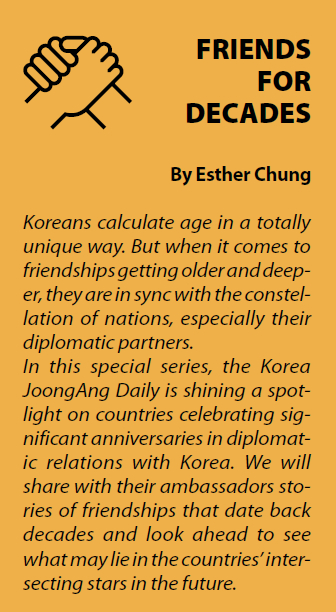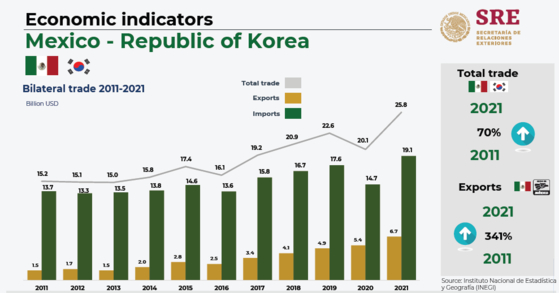[Friends for decades] Mexico, Korea remember forgotten soldiers
![Mexican veterans of the 1950-53 Korean War launch the first association of the Mexican veterans in Mexico City on April 25, 2021, at the diplomatic residence of the Korean ambassador to Mexico. The ceremony was held in the presence of Mexican and Korean ministers. [YONHAP]](https://koreajoongangdaily.joins.com/data/photo/2022/09/24/7b971874-8f60-4d95-ac11-27e1b972273f.jpg)
Mexican veterans of the 1950-53 Korean War launch the first association of the Mexican veterans in Mexico City on April 25, 2021, at the diplomatic residence of the Korean ambassador to Mexico. The ceremony was held in the presence of Mexican and Korean ministers. [YONHAP]
Friends of six decades try to bolster regional trade alliances

Where have I come to die, asked the thousands of Mexicans who arrived in Korea in 1950 to fight for the freedom and independence of a country they knew little about.
“Just imagine how strong the question was,” said Bruno Figueroa, ambassador of Mexico to Korea. “We’re talking about tragic and difficult moments for both communities, the first immigrants from Korea living in terribly harsh conditions in Mexico in 1905, and the soldiers fighting in a war not their own but suffering as any soldier would in a conflict.”
Around 1,033 Koreans settled in Yucatán to work on its henequen plantations in 1905. Henequen is a cactus-like plant that is harvested for its fibers, which are used for textiles. Many came on five-year contracts, after which they found their country had been lost to a Japanese invasion and annexation in 1910.
Now in their third or fourth generation, Korean-Mexicans have become a part of the fabric of Mexican society.
![Korean immigrants to Mexico's Yucatan Peninsula in 1905. [CORREO DEL MAESTRO]](https://koreajoongangdaily.joins.com/data/photo/2022/09/24/5eb15534-8133-45be-9ab7-7dfd87845945.jpg)
Korean immigrants to Mexico's Yucatan Peninsula in 1905. [CORREO DEL MAESTRO]
The process of healing has just begun for some of these veterans as the Korean and Mexican governments recognized their service for the first time last year.
The Mexican-Korean friendship, founded on blood, sweat and tears, celebrates its 60th anniversary this year, with a list of milestones.
Since the first state visits began in the 1990s, the two countries have seen a total of 10 presidential summits, and Korea is now Mexico’s third largest trading partner, after the United States and China.
Korea and Mexico began renegotiating a free trade agreement this month as Korea looks to apply to the Comprehensive and Progressive Agreement for Trans-Pacific Partnership (CPTPP), the 11-country FTA in the Asia-Pacific involving Mexico, Japan, Australia and other countries.
To hear more about how the nations are celebrating their six decades together, including with an unprecedented exhibition of 200 historical artifacts from the Aztec civilization at the National Museum of Korea this summer, the Korea JoongAng Daily sat down with Ambassador Figueroa at the Mexican Embassy in Seoul on March 10.
The following are edited excerpts of the interview.
![Ambassador of Mexico to Korea Bruno Figueroa speaks to the Korea JoongAng Daily at the Mexican Embassy in Seoul on March 10. [PARK SANG-MOON]](https://koreajoongangdaily.joins.com/data/photo/2022/09/24/51788831-4225-4cb9-be30-98977dca6105.jpg)
Ambassador of Mexico to Korea Bruno Figueroa speaks to the Korea JoongAng Daily at the Mexican Embassy in Seoul on March 10. [PARK SANG-MOON]
But that did not mean what had happened was forgotten – you can see the impact of the Korean War on Mexican culture, in movies and songs. In one song, “Carta de Corea [Letter from Korea],” the lyric speaks of a mother who receives a letter from her son in Korea that says he cannot return home because he is badly wounded. Many Mexicans died in the war – as many as 3,700 casualties – and that could make Mexico the third largest nationality in terms of UN forces’ casualties in the Korean War after the Koreans and Americans.
We are currently in contact with four Mexican veterans, and the Korean embassy in Mexico has launched a campaign to reach out to Mexican veterans of the war.
![Korea's Foreign Minister Chung Eui-yong, left, with Mexico's Foreign Minister Marcelo Ebrard, right, at a working meeting at Mexico's Mission to the UN in New York on Sept. 24, 2021. [EMBASSY OF MEXICO IN KOREA]](https://koreajoongangdaily.joins.com/data/photo/2022/09/24/ee849633-7cdc-4dbd-9b26-a2e99f81c6dc.jpg)
Korea's Foreign Minister Chung Eui-yong, left, with Mexico's Foreign Minister Marcelo Ebrard, right, at a working meeting at Mexico's Mission to the UN in New York on Sept. 24, 2021. [EMBASSY OF MEXICO IN KOREA]
Mexico is also a champion of non-proliferation of nuclear weapons and established the first nuclear free zone in Latin America. We know that Korea aims for denuclearization of the Korean Peninsula, and that is another common vision we share.
The FTA negotiations began in 2005 but were stopped after some sectors in both Mexico and Korea expressed concerns about the impact of the agreement. The good news is that the ministers of trade of both countries agreed on March 1 to relaunch the negotiations. We are confident that at the end of the process, we will reach a win-win agreement for both countries.

![Poster of the exhibition on the Aztec civilization at the National Museum of Korea from May 3 to Aug. 28. [NATIONAL MUSEUM OF KOREA]](https://koreajoongangdaily.joins.com/data/photo/2022/09/24/78c1c87e-b008-49c8-a4b3-6b4c3d00650e.jpg)
Poster of the exhibition on the Aztec civilization at the National Museum of Korea from May 3 to Aug. 28. [NATIONAL MUSEUM OF KOREA]
Coming up in May is an exhibition of more than 200 historical artifacts from the Aztec civilization, at the National Museum of Korea. The exhibition will run from May 3 to Aug. 28, and will be the first time ever that one of the most important civilizations of the Americas will be presented on this scale.
In Mexico, Korea will be the country guest of honor in the most relevant cultural festival of Mexico, the Cervantino Festival, which will be celebrating its 50th anniversary this year. In this festival in October, Korea will present many solo artists, dance, and musical groups, from classic to contemporary, as a way to disseminate its culture among the Mexican audience.
The governments of Mexico and Korea will continue working to recognize the thousands of Mexicans and Mexican-Americans who fought and, in many cases, gave their lives for the freedom of the Republic of Korea. In this effort, the embassy will host an exhibition at the War Memorial of Korea in June, where we will describe the participation of soldiers of Mexican origin during the Korean War. We expect the visit of some Mexican veterans, who will share their stories with the Korean public.
![Mexican diplomats and guests celebrate the opening ceremony of the Mexican Garden in the Suncheonman National Bay Garden on May 10, 2018. [EMBASSY OF MEXICO IN KOREA]](https://koreajoongangdaily.joins.com/data/photo/2022/09/24/595f8942-953c-4fd6-8f3a-bcaef5e0b390.jpg)
Mexican diplomats and guests celebrate the opening ceremony of the Mexican Garden in the Suncheonman National Bay Garden on May 10, 2018. [EMBASSY OF MEXICO IN KOREA]
But one of my personal milestones would be the time when I gained a hyungnim, or an older brother, in Korea. In Mexico, we address people older than us with don for men and doña for women, before their names, such as Don Roberto or Doña Alicia. I knew that in Korea there was a similar way of treating elder people with deference, and that there are many different titles to address people with deference, one of which is hyungnim, which is only used among people who have established a level of friendship and trust. So I was very proud when a Korean friend, who is an urban planner and architect who’s taught me a lot about Korean society, asked me to call him hyungnim. That’s a day I recall as one of my personal milestones in Korea.

Timeline of Mexico-Korea ties
1905 Korean immigrants in Yucatán
Around 1,033 Koreans settled in Mexico's Yucatán Peninsula to work at its henequen plantations in 1905. Many could not return to Korea after the Japanese annexation in 1910. To honor them, the city of Merida, the state capital of Yucatán, designated May 4 as the Day of Korea Immigrants in 2019, marking the first time in Mexico a day was designated to honor a foreign community.
![Korean immigrants arrive in Mexico in 1905 to work at the henequen plantations in the Yucatan Peninsula. [MUSEO CONMEMORATIVO DE LA INMIGRACION COREANA A YUCATAN]](https://koreajoongangdaily.joins.com/data/photo/2022/09/24/b940d6f3-c885-471d-bf35-f2a0adbc57db.jpg)
Korean immigrants arrive in Mexico in 1905 to work at the henequen plantations in the Yucatan Peninsula. [MUSEO CONMEMORATIVO DE LA INMIGRACION COREANA A YUCATAN]
1950 Mexican soldiers in Korean War
As many as 100,000 soldiers of Mexican origin came to fight in the 1950-53 Korean War, under the flag of the United Nations. The first association of the Mexican veterans was established last year in the presence of Mexican and Korean ministers.
1962 Establishment of ties
Mexico and Korea established relations in January 1962. Korea opened its embassy the same year, and Mexico in 1978. Within a few years of establishment of ties, Korea built a pavilion for the 1968 Mexico City Olympics, which to this day stands in Chapultepec Park in the city.
1988 First Samsung factory opens
The first Samsung factory opened in Tijuana in 1988. Today, around 400 Korean companies operate in Mexico, with about 15,000 Koreans working across the country. Bilateral trade reached more than $23 billion in November of 2021, making Korea Mexico's third largest trading partner, while Mexico is Korea's biggest trading partner in Latin America and ninth in the world.
![Samsung factory in Tijuana in this file photo dated 2020. [SAMSUNG ELECTRONICS]](https://koreajoongangdaily.joins.com/data/photo/2022/09/24/c84f141d-e883-46c2-afda-90afb690e393.jpg)
Samsung factory in Tijuana in this file photo dated 2020. [SAMSUNG ELECTRONICS]
In 1991, Korean president Roh Tae-woo visited Mexico for the first time. This visit, the first of a Korean president to Latin America, opened dialogue at the highest level. The first Mexican state visit to Korea took place in 1996 when President Ernesto Zedillo came to Seoul and met with President Kim Young-sam. To date, 10 presidential visits between the two nations have taken place.
![Korean President Roh Tae-woo, left, with Mexican President Carlos Salinas de Gortari, right, during Roh's state visit to Mexico in 1991, which marked the first Korean state visit to Mexico. [JOONGANG PHOTO]](https://koreajoongangdaily.joins.com/data/photo/2022/09/24/4abebad9-ed21-4955-a8da-36b4bf099ac2.jpg)
Korean President Roh Tae-woo, left, with Mexican President Carlos Salinas de Gortari, right, during Roh's state visit to Mexico in 1991, which marked the first Korean state visit to Mexico. [JOONGANG PHOTO]
![Mexican President Ernesto Zedillo, left, and Korean President Kim Young-sam, right, during Zedillo's state visit to Korea in 1996, which marked the first Mexican state visit to Korea. [JOONGANG PHOTO]](https://koreajoongangdaily.joins.com/data/photo/2022/09/24/216372dc-beb3-4b76-a0b7-56ae74a6f919.jpg)
Mexican President Ernesto Zedillo, left, and Korean President Kim Young-sam, right, during Zedillo's state visit to Korea in 1996, which marked the first Mexican state visit to Korea. [JOONGANG PHOTO]
In 2005, Mexico and Korea elevated their ties to a Strategic Association for Mutual Prosperity, pledging closer bilateral relations within the political, economic, educational, cultural, scientific, and technological realms. Bilateral FTA negotiations began the same year.
2017 Aeromexico direct flights
The inaugural direct flight between Mexico City and Incheon took place on July 1, 2017, which reduced travel time between the two cities to 15 hours. The two countries at the time were experiencing growing people-to-people exchanges, which jumped from 32,000 in 2012 to 86,000 in 2019, according to the Mexican Ministry of Tourism.
2022 60th anniversary
On the occasion of the 60th anniversary of diplomatic relations, the Mexican and Korean governments published a commemorative book to highlight milestones. On Feb. 6, the Mexican Embassy in Seoul hosted the Korea-Mexico 60 Years' Friendship concert by the United Philharmonic Orchestra at the Seoul Arts Center. From May 3 to Aug. 28, an exhibition of 200 historical artifacts from the Aztec civilization will be held at the National Museum of Korea. In June, an exhibition dedicated to Mexican veterans of the Korean War will be held at the War Memorial of Korea. Korea will be the guest of honor at the Cervantino Festival in Mexico in October.
BY ESTHER CHUNG [chung.juhee@joongang.co.kr]










with the Korea JoongAng Daily
To write comments, please log in to one of the accounts.
Standards Board Policy (0/250자)